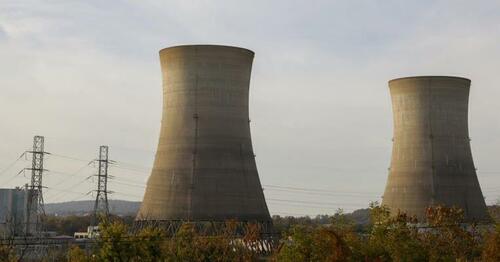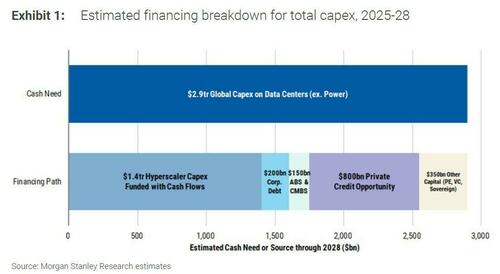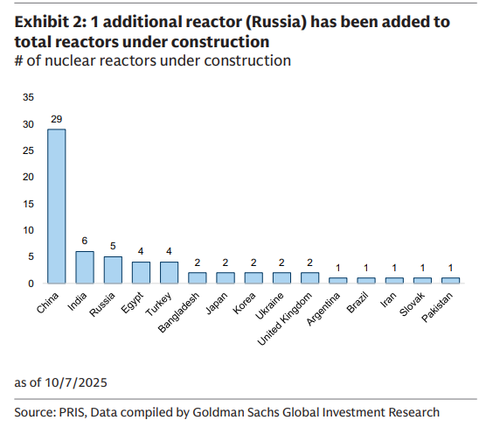Trump Admin To Lend "Hundreds Of Billions" To Build Nuclear Power Plants
While the market is finally starting to grapple with the most unpleasant question of who will plug the funding gap needed to build out all the data centers required to make the AI dream a reality, a gap which Morgan Stanley recently calculated would be as large as $2.9 trillion in capex funding needs, of which at least $1 trillion will come in the form of debt (and mostly private debt)...
... there is another, just as critical question: who will fund the energy buildout that powers these data centers?
Recall, last December Morgan Stanley calculated that the US would need at least 36GW in new power to be brought online by 2028 to energize all the (yet to be built) data centers, a number which one year later is surely far higher.
And at a cost of $50-60BN per GW of power, we can quickly add several more trillion dollar that will be needed in the next several years: money, which as this Bloomberg article makes painfully clear, are simply not available right now.
So where will this money come from?
Why the US government of course.
By now it should be clear to all but the most purple-haired libs that the US will need nuclear power plants - both conventional and modular - and lots of them, to have even a remote chance of ever catching up to the ever growing energy needs... and as we said recently, one can print money, but one can't print energy.
The money is not the problem: AI is the new global arms race, and capex will eventually be funded by governments (US and China). If you want to know why gold/silver/bitcoin is soaring, it's the "debasement" to fund the AI arms race.
But you can't print energy https://t.co/qwdD8QbVON
— zerohedge (@zerohedge) October 14, 2025
But they sure can try.... and according to Secretary Chris Wright, nuclear power will receive most of the money from the Energy Department's Loan Programs Office (LPO) as the Trump administration pushes to quickly break ground on new reactors. According to Reuters, The LPO has hundreds of billions of dollars in financing aid, including loan guarantees for projects that struggle to get bank loans.
"We have significant lending authority at the loan program office," the Secretary of Energy said at a conference hosted by the American Nuclear Society in Washington D.C. "By far the biggest use of those dollars will be for nuclear power plants, to get those first plants built. The U.S. currently has no commercial nuclear reactors being built, though several intend to reverse their permanent shutdown status and open again, and there are other plans to build new large and small reactors."
During Trump's first term in the White House, the only use he made of the LPO was for financing reactors at the Vogtle nuclear power plant in Georgia. Expect a flood of debt deals in the coming weeks and months as the clock is ticking for the US to catch up to China, which currently has 29 reactors under construction to America's zero.
As we reported at the time, President Trump signed an executive order in May that called for the US to break ground on 10 large nuclear reactors by 2030, while Alphabet, Amazon, Meta Platforms and Microsoft have been investing billions of dollars to restart old nuclear plants, upgrade existing ones, and deploy new reactor technology to meet the electricity demand from artificial intelligence data centers. Others are also joining the fray, but as Sam Altman made clear, everyone is expecting the US government to the be the "insurer of last resort."
Wright said he expects electricity demand from AI to attract billions of dollars in equity capital to build new nuclear capacity from "very creditworthy providers." The Energy Department could match those private dollars by as much as four to one with low cost debt financing from the loan office, he said.
"When we leave office three years and three months from now, I want to see hopefully dozens of nuclear plants under construction," Wright said. Make that all hyperscaler CEOs too because without those dozens of nuclear plants, guess what: the AI bubble is going to burst in the most spectacular fashion.
 Cooling towers at the Three Mile Island nuclear power plant in Middletown, Pennsylvania, Oct. 30, 2024
Cooling towers at the Three Mile Island nuclear power plant in Middletown, Pennsylvania, Oct. 30, 2024The Trump administration tipped its cards last month when it struck a deal with the owners of Westinghouse to invest $80 billion to build nuclear plants across the US. Westinghouse is owned by uranium miner Cameco and Brookfield Asset Management (both Canadian companies).
Westinghouse has designed a modern reactor called the AP1000 that can power more than 750,000 homes. CEO Dan Sumner said in July that Westinghouse would meet Trump's call to build large new plants with the AP1000 design. But Westinghouse has struggled in the past to build the AP1000 on time and on budget. And as a stark indication of just how capital intensive building NPPs can be, Westinghouse went bankrupt in 2017 from cost overruns at big nuclear projects in Georgia and South Carolina.
Which, naturally, opens the door wide open to far cheaper projects from small modular reactor developers such as Oklo and Nano Nuclear.
Cameco Chief Operating Officer Grant Isaac said last week that the U.S. government has a number of options available to facilitate the financing of Westinghouse reactors, including the Energy Department's loan office.
"We're assured that there is a lot of interest in investing this minimum $80 billion in order to begin the process," Isaac told investors on Cameco's third-quarter earnings call.
Under the terms of the October deal, Westinghouse could spin out as a separate, publicly-traded company with the U.S. government as a shareholder.
Loading recommendations...



